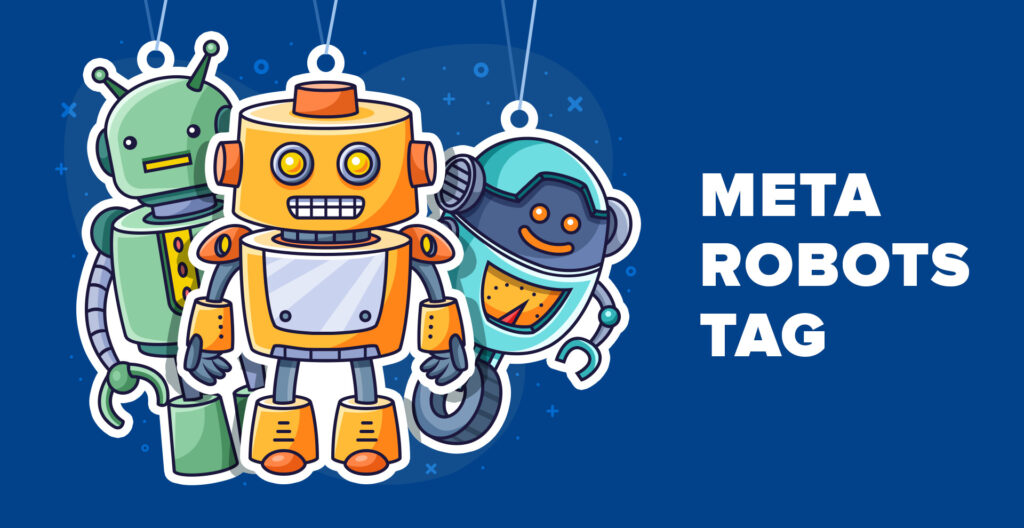Knowing the subtleties of how search engines interact with your website is essential in the ever changing field of Search Engine Optimization (SEO). Robots tags are one of the many factors that affect how search engines scan and index your website. This extensive blog post examines the use of robots tags in search engine optimization, as well as their benefits, drawbacks, and accessible solutions for efficient management.
What Are Robots Tags?
Robots tags, also known as meta robots tags, are HTML elements used to instruct search engine crawlers on how to index and follow content on a webpage. They provide directives to search engine bots about which pages should be indexed and which should not, as well as how they should be treated during crawling.
Basic Syntax of Robots Tags
Robots tags are placed in the <head> section of a webpage’s HTML code. The basic syntax looks like this:
htmlCopy code<meta name="robots" content="directive1, directive2">
Directives can include:
indexornoindex: Determines whether the page should be indexed.followornofollow: Determines whether links on the page should be followed.noarchive: Prevents search engines from showing a cached version of the page.nosnippet: Disables the display of snippets or previews in search results.noodp: Prevents the use of the Open Directory Project (ODP) description.
Importance of Robots Tags in SEO
Robots tags are essential for several reasons, each impacting how search engines interact with your site and ultimately affecting your SEO efforts.

1. Control Over Indexing
Robots tags give you control over which pages of your site are indexed by search engines. This is particularly important for:
- Avoiding Duplicate Content: Preventing multiple versions of the same content from appearing in search results.
- Managing Sensitive Content: Ensuring that private or sensitive pages are not indexed.
- Directing Crawlers: Guiding search engine bots to focus on important pages and avoid less relevant ones.
2. Enhancing Crawl Efficiency
By using robots tags to exclude certain pages or sections, you help search engines focus their crawling resources on your most important content. This can improve the efficiency of the crawling process and ensure that search engines spend more time on high-value pages.
3. Optimizing Site Performance
Efficient crawling and indexing can lead to better site performance in search engine results. By controlling what gets indexed, you can improve the relevance of your search listings and potentially enhance your rankings for key terms.
4. Customizing Search Results
Robots tags can influence how your pages appear in search results. For instance, using nosnippet can prevent search engines from showing a snippet or preview of a page, which might be beneficial for certain types of content.
Usefulness of Robots Tags
Robots tags are valuable tools for SEO management and optimization. Here’s how they can be useful:
1. Preventing Indexing of Low-Value Pages
Pages like login screens, admin sections, or duplicate content do not typically add value to search results. Robots tags allow you to prevent these pages from being indexed, ensuring that only valuable and relevant content appears in search results.
2. Managing Crawl Budget
Search engines have a limited crawl budget for each site, which is the amount of time and resources they allocate for crawling a site. By using robots tags to exclude less important pages, you help ensure that the crawl budget is used more effectively on high-priority pages.
3. Handling Duplicate Content
Duplicate content can negatively impact SEO by causing confusion about which version of a page should rank. Robots tags can help manage duplicate content issues by ensuring that search engines only index the preferred version of a page.
4. Controlling Snippets
Sometimes, you may not want certain pages to display snippets in search results. For example, for a page with a specific promotional offer or detailed technical information, you might want to use nosnippet to control what users see in search results.
5. Directing Crawlers
Robots tags can direct search engines to follow or not follow links on a page. This can be useful for controlling the flow of link equity and managing how search engines navigate your site.

Advantages of Robots Tags
Using robots tags effectively can offer several advantages for your SEO strategy:
1. Enhanced Control Over Indexing
With robots tags, you gain precise control over which pages are indexed and which are excluded. This level of control helps you manage how search engines interact with your site, focusing their attention on the most important content.
2. Improved SEO Performance
By excluding low-value or duplicate pages, you can improve your site’s overall SEO performance. Search engines can better understand and prioritize your key content, potentially leading to better rankings and visibility.
3. Optimized Crawl Budget Usage
Efficient use of your crawl budget ensures that search engines spend their resources on indexing and ranking your most valuable pages. This can enhance the overall performance of your site in search results.
4. Customization of Search Results
Robots tags allow you to customize how your content appears in search results. Whether you want to hide snippets or prevent certain pages from appearing, robots tags provide the flexibility to tailor search results to your preferences.
5. Management of Sensitive Information
For sites that handle sensitive or confidential information, robots tags can prevent certain pages from being indexed and accessed through search engines. This adds a layer of privacy and security.
Disadvantages of Robots Tags
While robots tags offer significant advantages, they also come with potential drawbacks:
1. Potential for Misconfiguration
Incorrectly using robots tags can lead to unintended consequences, such as accidentally excluding important pages from indexing or causing indexing issues. It’s crucial to configure robots tags carefully to avoid these pitfalls.
2. Complexity in Large Sites
For large sites with numerous pages, managing robots tags can become complex. Ensuring that the correct tags are applied to the right pages requires careful planning and monitoring.
3. Impact on Analytics
When using noindex, pages are excluded from search engine indexes but may still be accessible to users. This can affect analytics and tracking, as these pages will not appear in search engine results but might still receive traffic from other sources.
4. Limited to Search Engines
Robots tags only influence how search engines interact with your site. They do not affect other aspects of web visibility, such as social media sharing or direct traffic.
Tools for Managing Robots Tags
Several tools and resources can help you manage and optimize robots tags effectively:
1. Google Search Console
Google Search Console provides valuable insights into how Googlebot crawls and indexes your site. You can use it to test robots tags, check for indexing issues, and monitor the performance of your pages in search results.
2. Bing Webmaster Tools
Similar to Google Search Console, Bing Webmaster Tools offers features to help you manage your site’s presence in Bing’s search engine. You can use it to check and manage robots tags and monitor indexing status.
3. Screaming Frog SEO Spider
Screaming Frog is a popular SEO tool that allows you to crawl your site and analyze robots tags. It helps identify issues such as missing or incorrect tags and provides insights into how search engines interact with your content.
4. Yoast SEO Plugin
For WordPress users, the Yoast SEO plugin simplifies the management of robots tags. It offers easy-to-use settings for controlling indexing, follow directives, and other aspects of SEO optimization.
5. SEO Audit Tools
Various SEO audit tools, such as SEMrush, Ahrefs, and Moz, provide comprehensive site analysis, including robots tag management. These tools help identify potential issues and offer recommendations for optimization.

Conclusion
Robots tags are a powerful component of SEO strategy, offering control over how search engines index and interact with your website. By understanding and effectively using robots tags, you can enhance your site’s SEO performance, manage crawl budgets, and tailor search results to better reflect your content’s value.
Despite their advantages, it’s essential to handle robots tags carefully to avoid misconfiguration and ensure that important pages are not inadvertently excluded from indexing. Leveraging tools like Google Search Console, Screaming Frog, and SEO plugins can help you manage robots tags efficiently and maintain a well-optimized website.
As search engines and SEO practices continue to evolve, staying informed about best practices for robots tags will help you navigate the complexities of SEO and maximize the effectiveness of your digital presence. GMI



